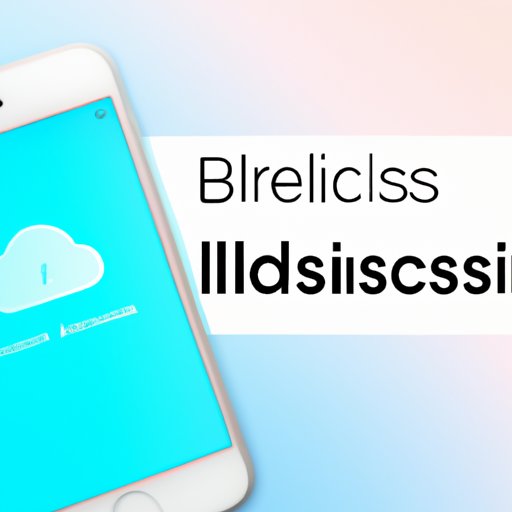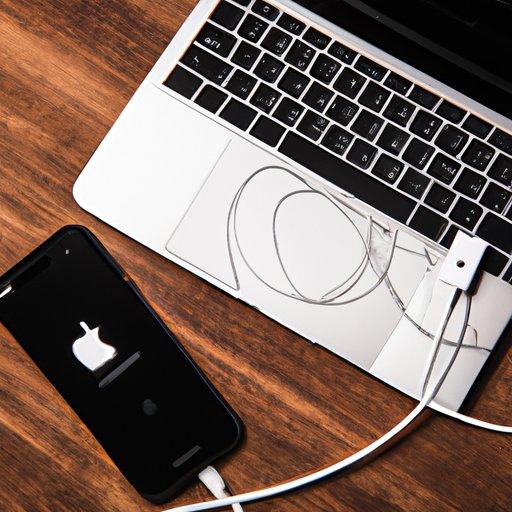Introduction
Connecting an iPhone to a MacBook can be frustrating and confusing. With different cables, wireless options, and software, it’s hard to know where to start. This article provides a comprehensive guide on how to connect your iPhone to your MacBook with ease. From wired to wireless, we cover all the methods available.
Step-by-Step Guide: How to Connect Your iPhone to Your MacBook in Minutes
The most common way to connect your iPhone to your MacBook is by using a cable. Follow these simple steps to connect your iPhone to your MacBook using a cable:
- Connect the USB end of the cable to the USB port on your MacBook.
- Connect the other end of the cable to the Lightning port on your iPhone.
- Unlock your iPhone and tap ‘Trust’ on the pop-up message that appears on your phone. This will enable your MacBook to access your phone.
To ensure a smooth connection, make sure both devices are turned on, the cable is not damaged, and the cable is properly plugged in.

Wireless Bliss: Sync Your iPhone with Your MacBook Using AirDrop and iCloud
Connecting your iPhone to your MacBook wirelessly has several benefits, including convenience and saving time. To connect your devices, you can use Apple’s AirDrop or iCloud. Here’s how:
AirDrop
- Make sure both your iPhone and MacBook have AirDrop turned on.
- Open a Finder folder on your MacBook and look for the AirDrop icon on the left sidebar.
- On your iPhone, open the photo or file you want to transfer and tap the Share button.
- Select the AirDrop icon and choose your MacBook from the list of available devices.
- Your MacBook will receive a notification to accept the file. Accept, and the transfer will begin.
iCloud
- On your iPhone, go to Settings and tap on your name, then tap iCloud.
- Enable iCloud Drive and choose the files you want to sync between devices.
- On your MacBook, open a Finder folder and enable iCloud. Your iCloud Drive files and folders should appear in your Finder sidebar.
The Ultimate Hack: Connect Your iPhone to MacBook without a Cable
If you don’t have a cable, don’t worry! It’s still possible to connect your iPhone to your MacBook without one. Here’s how:
Personal Hotspot
- On your iPhone, go to Settings and tap Personal Hotspot. Turn on Personal Hotspot.
- On your MacBook, click on the Wi-Fi icon on the top bar and select your iPhone’s name from the list of available networks.
- Enter the password displayed on your iPhone, and you should be connected to the internet.
Share Media and Files between iPhone and MacBook using iTunes
iTunes is a popular tool to connect your iPhone to your MacBook. It enables you to sync media, including music, photos, and videos, between devices. To connect your devices using iTunes, follow these steps:
- Launch iTunes on your MacBook and connect your iPhone using a cable.
- Click the iPhone icon in the top bar of iTunes.
- Select the content from the tabs at the top, including Music, Movies, and Photos.
- Choose the content you want to sync from your MacBook to your iPhone and click Apply.
Effortlessly Connect Your iPhone to MacBook with Bluetooth Technology
If you don’t want to use a cable, Bluetooth technology offers a wireless option to connect your iPhone to your MacBook. Here’s how:
- Turn Bluetooth on your iPhone and MacBook.
- On your MacBook, click on the Bluetooth icon on the top bar and select ‘Set Up Bluetooth Device.’
- Select your iPhone from the list of available devices and click ‘Pair’.
- Enter the code that appears on both devices.
Quick and Easy: How to Connect Your iPhone to Your MacBook using USB cable
If you’re looking for a more in-depth guide on using a USB cable to connect your iPhone to your MacBook, here are some additional steps:
- Make sure your iPhone is updated to the latest iOS version.
- Connect the USB end of the cable to your MacBook and the Lightning end of the cable to your iPhone.
- If prompted, enter your iPhone passcode or choose Trust This Computer.
Troubleshooting Guide: Resolving Common Connection Issues between iPhone and MacBook
Despite best efforts, sometimes connection issues may arise. Here are some common issues and solutions to help troubleshoot:
Problem: My iPhone is not recognized by my MacBook.
- Make sure your iPhone is turned on and not locked.
- Check that the cable is properly plugged in and not damaged.
- Update your iPhone and MacBook to the latest software versions.
- Restart your iPhone and MacBook.
Problem: My Wi-Fi connection is slow.
- Make sure you have a stable Wi-Fi connection.
- Restart your Wi-Fi router.
- Turn off any devices that are not in use.
- Make sure your iPhone and MacBook are not too far from the router.
Conclusion
Connecting your iPhone to your MacBook can be a challenge, but there are several ways to do it. From using a cable to connecting wirelessly, we’ve covered all the methods here. We hope this guide has helped you to connect your devices with ease. If you’re still experiencing issues, Apple Support provides further resources and troubleshooting.
